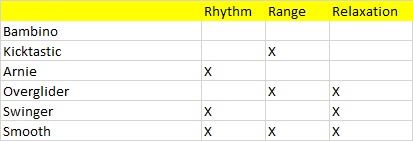
Estimated swim economy: 0 (s@1L)
The calculator will look at the relationship between your increase in pace (with an increase in physiological effort) along with any increase or decrease in stroke length for a given physiological effort to better quantify your own rhythm, range and relaxation in the water. These are shown on the bar chart below
Relaxation10/10
Range5/10
Rhythm5/10
Overall Swim Score: 20/30
How did you do?
You'll also see a total efficiency score (out of 30 -- which would represent my perfect 10 out of 10 on rhythm, range and relaxation). Mr Popov would ace this test! :-) If you're an Ironman competitor, with Kona aspirations, you want to score 25+
How to interpret the test
If you score below 7 in any of the 3, consider it a potential limiter worthy of some attention. You may find that you have more than one limiter under the 7 mark. This simply indicates that you have a lot of upside on the technical side of things & will benefit quickly from a dedicated technical focus block! On the flipside, if you're 'high and balanced' across all 3, bad news for you: Your route to improvement is fitness, in other words - YARDS! :-) For additional context, and a bit of a clue on where this is headed for each of the limiters, you can then refer back to my take on how these limiters tie in to Swim Smooth's Swimtypes (no X in the box indicates a limiter)You may want to check out http://www.swimtypes.com/overglider.html for more information specific to your rhythm/range/relaxation combo

This algorithm is just a high tech version of the old 'swim golf' game -- where you take your speed and your stroke count and add them together for a total score. While that concept is a useful one, the weighting isn't fair and can lead to some suboptimal messages regarding optimal technique. E.g. A normal 25m sprint for me might be 14s and 15 strokes for a score of 29 but if I kick a 25 hard on my side and don't take any strokes, I could pretty comfortable do it in 22s or so, leading to a score of 22+0 = 22!. While this is an extreme example, you can see the danger in putting too much emphasis on this (non weighted) metric
Once you are aware of (& able to somewhat quantify) your limiters, you can have a much more focused plan of attack to the technical aspect of your swim training. Rather than having a myriad of drills that may or may not work against your limiter, you can stick to a handful of drills that are specifically designed to address your personal weakpoints. Furthermore, you can use the calculator above to help to better quantify whether you're improving and in what direction you're improving. Sometimes it's a bit like a game of spinning plates. If you spend too much time trying to improve your weakness, you may wind up losing some of your natural strengths so it is important to keep both in mind and in view. In other words, you don't want that total score of 20 to go down!
For you personally, that means that we want to focus strongly on your weakness of range while also making sure we don't lose your natural strength in relaxation In my next article in the series we'll look at what a block of technique training might look like for you, along with some specific drill sets designed to nudge up the range of your stroke. Until then...